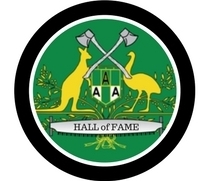Norman (Norrie) Eaves – Tasmania
Area Born: Smithton
Area/Areas Resided: Roger River, Penguin, Elliot, Waratah, Yolla, Burnie and Somerset
Date of Birth: 1st February 1931
Family Names – Mother, Father: Ruby and George Eaves
Wife: Yvonne
Children: Gregory, Carol, Neville, Trevor, Janice and Michael
Occupation, where worked: Bricklayer (self employed) and APPM
Favorite passtime/hobbies: Playing golf, reading and watching sport
Favourite discipline in woodchopping: Standing block
Records, event type, date, whereabouts:
- Won fut standing at New Year’s Day Sport Carnival (1953)
- Won foot standing in a time of 18.25 seconds at New Year’s Day Sports Carnivall (1968)
- Won foot standing at Royal Melbourne Show (1978)
- Won several foot handicaps over the years
Achievements
- Won double-handed sawing handicap with Vic Jaeger (Dec) and Sydney Royal Easter Show (1949)
- Won singe-handed Tasmanian Sawing Championship at Wynyard Show (1976)
- Won single-handed Tasmanian Sawing Championship (dead heat with Bill Youd) at Campbelltown Show (1977)
Something memorable about the inductee (may be several things):
- Selected to saw single-handed for Tasmania in World Championships in Ulverstone (1977)
- Live Membership – North Western Axemen’s Association Inc
- Award of Merit – Australian Axemen’s Association (in recognition of outstanding services to the Association and the sport in general)
My time as an axemen and sawyer
The most satisfying time of my chopping and sawing career was in the early 1970’s when I started making racing saws. At that time, it was impossible to buy small M tooth saws.
Years ago, racing saws were very thin and quite easy to break. I remember at one Carnival, my brother Dodley broke his single-handed saw in several places and my other brother Harry and I both latched onto the piece of broken saw. For years after, whenever I filed a saw, out would come the piece of broken saw as a guide.
Then an idea came to me to make a racing saw out of a place of band saw. Everything went great until I cut the saw into the wood. The first couple of strokes were good, then nothing. All the points had hooked over. It was a great deal of hard work and it was disappointing not to get the result I was aiming for.
I made some enquiries, thinking that an engineering firm may be able to harden steel, but had no luck. Then one day, I was reading my son’s metalwork book from High School and there was an article on how to harden and temper steel. It was a real success and Harry and Royce Berwick followed on with this idea and made many saws using this method.
The success I have gained with saw sharpening, I give some of the credit to Dudley who was the Master of the Art.
It is a privilege to give something back towards the sport in preparing competitors’ saws and to encourage them to continue on and promote sawing and support woodchopping into the future.
Dated: 8th January 2011
…


